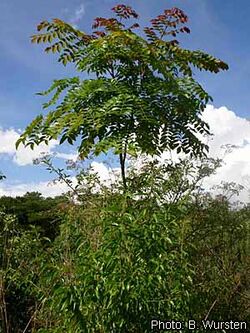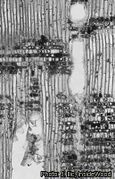Acrocarpus fraxinifolius
Aller à la navigation
Aller à la recherche
Acrocarpus fraxinifolius
Wight ex Arn.
| Ordre | Fabales |
|---|---|
| Famille | Fabaceae |
| Genre | Acrocarpus |
2n = 24
Origine : Asie tropicale
sauvage et planté
| Français | ' |
|---|---|
| Anglais | pink cedar tree |
Résumé des usages
- bois d'œuvre
- bois de feu, charbon de bois
- pâte à papier
- arbre d’ornement
- fourrage
- mellifère
- stabilisation des rives
- arbre d'ombrage (caféiers, théiers)
- brise-vent
Description
-
1, port de l'arbre ; 2, feuille ; 3, inflorescence ; 4, fleur ; 5, fruit. Source: PROSEA
-
coupe transversale du bois
-
coupe tangentielle du bois
-
coupe radiale du bois
Noms populaires
| français | |
| anglais | pink cedar tree, Indian ash, shingle tree (PROTA); red cedar (Mansfeld) |
| Inde | konné, kurangan, mandling (Mansfeld) |
| Bengale | mandania (Mansfeld) |
| Malaysia | karingodi (Mansfeld) |
| Birmanie | mayahnin, yedama (Mansfeld) |
| Java | delimas (Mansfeld) |
| Sumatra | madang pariek (Mansfeld) |
Classification
Acrocarpus fraxinifolius Wight ex Arn. (1838)
Cultivars
Histoire
Usages
Cultivated as a shade tree for coffee plantations (India) and tea plantations (Sumatra, Java). Also in Africa (Cameroon, Tanzania, Malawi, Nigeria, Zimbabwe, Zambia) sometimes cultivated. The wood is utilized in the manufacture of shingles, tea boxes, furniture and for building purposes.
Mansfeld.




